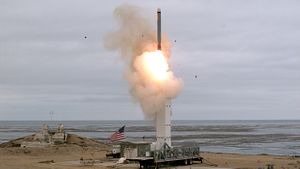The demise of a landmark arms control accord earlier this month means that U.S. intermediate-range missiles could soon be fielded to the western Pacific, and Pentagon leaders will likely consider Japan’s Ryukyu Islands and the Republic of Palau in Micronesia their most viable basing options.
On August 3, a day after the United States formally exited the Intermediate-Range Nuclear Forces (INF) Treaty with Russia, recently confirmed U.S. Defense Secretary Mark Esper remarked that he hoped to see previously banned missile types deployed to Asia “sooner rather than later.”
Signed by Ronald Reagan and Mikhail Gorbachev in 1987, the INF Treaty banned ground-launched ballistic missiles and cruise missiles with ranges of 500 to 5,500 kilometers, applicable to conventional weapons as well as to those with nuclear warheads.
Two weeks following Esper’s comments, on California’s San Nicolas Island, a U.S. Department of Defense video showcased the fiery exit of a Tomahawk cruise missile variant from its upright, ground-mobile Mark 41 launcher – an overt announcement that such systems are mature, or very close to it.
Now unfettered, the United States seems keen to equip its Indo-Pacific Command with such weapons, especially when the Chinese People’s Liberation Army boasts the “largest and most diverse missile force in the world,” according to former four-star U.S. admiral Harry Harris.
Guam is a key American military base and logistics hub, but “China no doubt has every inch of the island targeted,” according to one arms control analyst. Instead of concentration on Guam, distributing missiles throughout the first island chain, an arcing line running from the Kuril Islands through Japan, Taiwan, the Philippines, and then west through Indonesia, would be more survivable, and more effective.
Strategist Andrew Krepinevich’s “archipelagic defense” concept has won adherents in the U.S. Congress, most notably Representative Michael Gallagher, a Marine Corps veteran with a doctorate in international relations. Gallagher explains that traditional mobilization is too lethargic, that “rather than waiting for ships surged from San Diego to arrive and respond” the United States instead needs forces forward-deployed and primed to repel an invasion of Taiwan, for instance. Nimble troops with conventional missiles in the first island chain could “move constantly, holding a greater number of Chinese targets at risk” while confounding enemy counter-targeting efforts.
The Philippines boasts thousands of islands, several of which are familiar to U.S. military planners through the annual Balikatan exercise. But unless Manila’s bilateral relations with China significantly deteriorate, American missiles won’t be welcome, as Duterte no doubt noted South Korea’s scars from the Chinese tourist boycott and economic backlash after Lotte Group provided land for an American missile defense battery. Philippine President Rodrigo Duterte is currently on his fifth official visit to China, seeking economic gains for his country from Chinese investment.
As for Taiwan, the arrival of American-operated missiles would prove wantonly provocative and severely escalate cross-strait tensions, sparking a fourth Taiwan Strait crisis.
Though Japan might internally grapple with a hosting request, such cooperation is ultimately in line with its strategic interests. While Japanese Prime Minister Shinzo Abe is oft quoted as stating that it was “not desirable to create a circumstance” in which the INF Treaty would be dissolved, the Japanese government later switched its position in support of U.S. withdrawal. Japan’s own missile posture was discussed at a meeting of the National Security Secretariat in March.
New Japanese bases for surface-to-air and anti-ship missiles opened on March 26 – two on Amami Oshima north of Okinawa, and one on Miyako to its south. Another base is under construction on Ishigaki, between Miyako and Taiwan.
American ground-mobile missile batteries would cause the least environmental disruption and local consternation if established as tenants at these small Japan Ground Self-Defense Force bases in the Ryukyus – with U.S. personnel sharing security responsibilities, renting space, electricity, and water, and periodically running scenarios alongside Japanese counterparts. Such deployments would bypass entrenched anti-American sentiment on Okinawa itself, and could help reinforce Japanese oversight of the Senkaku Islands contested by China, only a few hundred kilometers westward.
To fortify the southern portion of the first island chain, the Pentagon may look to Palau. The Compact of Free Association with Palau provides the United States with exclusive military access and allows the U.S. to “establish and use defense sites” in exchange for fair compensation. Situated on the second island chain, a thousand kilometers east of the gap between the southern Philippine island of Mindanao and Indonesia’s North Sulawesi, conventional ballistic missiles from Palau could overfly the Philippines en route to targets in the South China Sea, Luzon Strait, or beyond.
A recent op-ed penned by Palau’s President Tommy Remengesau explained that the country’s maritime port and its airports on Angaur and Peleliu require substantial modernization, and explicitly embraced “a larger U.S. armed forces and law enforcement presence in our archipelago as a deterrent.”
In April, for the first time in 37 years, U.S. Army troops visited Palau, providing health outreach services, road repair, and training opportunities for the Palauan Security Forces.
Perhaps late next year, U.S. Army missile batteries could begin arriving as well.
Evan Karlik is a lieutenant commander in the U.S. Navy. He spent his early childhood in Western Samoa and the Philippines, and was stationed in Hawaii from 2011 to 2014. He served last year as a Defense Fellow in the U.S. House of Representatives. The views expressed herein are solely his own and are in no way intended to reflect the official position of the U.S. Department of Defense or the U.S. government.

































